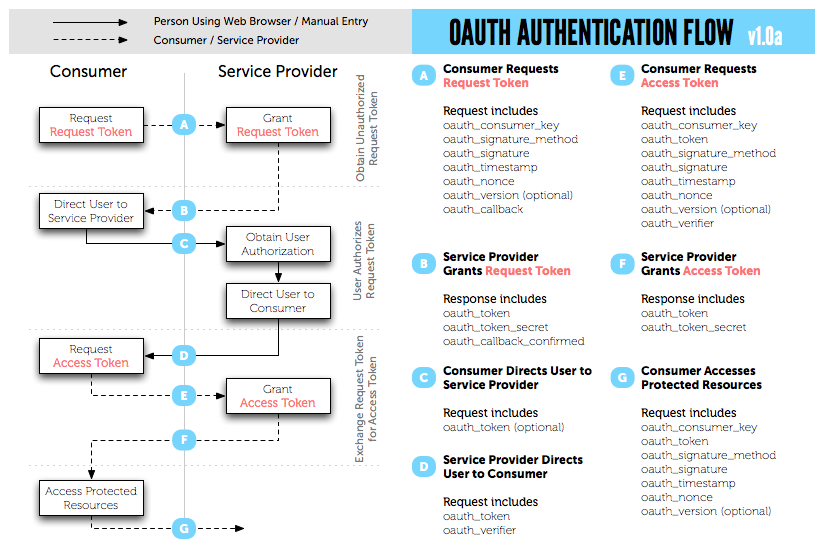OAuth 1.0 Authentication
Note that this configuration option is not yet supported and the test endpoint button will not work.
OAuth 1.0 authentication is one of the two OAuth methods and
is supported only for published components.
It is configured by setting the type key to oauth10:
{
"api": {
...,
"authentication": {
"type": "oauth10"
}
},
"config": {
...
}
}No other configuration parameters are necessary (nor available). The OAuth authentication process is described by the following diagram:

In the diagram, only the step G represents the actual communication with the API (extraction of data).
The final authorization section of the Generic Extractor configuration is generated between
steps F and G. When a component is published, the steps A - F of the process are handled by
Keboola (and the end-user).
To develop and test a new component with the OAuth authorization, go through
the steps A - F manually. At the last step, you obtain a response containing the fields
oauth_token and oauth_token_secret, e.g.:
{
"oauth\_token": "JohnDoe1234",
"oauth\_token\_secret": "TopSecret5678"
}Then, inject the OAuth credentials into the configuration root:
{
"parameters": {
"api": {
...
},
"config": {
...
}
},
"authorization": {
"oauth_api": {
"credentials": {
"#data": "{\"oauth\_token\":\"JohnDoe1234\",\"oauth\_token\_secret\":\"TopSecret5678\"}",
"appKey": 1234,
"#appSecret": "TopSecret"
}
}
}
}The authorization field has a single property oauth_api, which has a single property credentials with three child properties:
#data— contains the response from the service provider, the response is a JSON string (not an object!).appKey— contains the Consumer Key.#appSecret— contains the Consumer Secret (use an empty string if not used by the service provider).
With the above configuration, Generic Extractor generates the Authorization header; the signature
method used is HMAC-SHA1. For example:
Authorization: OAuth oauth_consumer_key="1234", oauth_nonce="72469d96572dabb4d0ea02b057ea4f246d722b72", oauth_signature="zl0y5CyySCPj8IqODV3Egjqgg6Q%3D", oauth_signature_method="HMAC-SHA1", oauth_timestamp="1492904452", oauth_token="JohnDoe1234", oauth_version="1.0"
The full configuration is, e.g.:
{
"parameters": {
"api": {
"baseUrl": "http://example.com/",
"authentication": {
"type": "oauth10"
}
},
"config": {
"debug": true,
"outputBucket": "mock-server",
"jobs": [
{
"endpoint": "users",
"dataType": "users"
}
]
}
},
"authorization": {
"oauth_api": {
"credentials": {
"#data": "{\"oauth_token\":\"userToken\",\"oauth_token_secret\":\"tokenSecret\"}",
"appKey": 1234,
"#appSecret": "TopSecret"
}
}
}
}See example [EX102] or learn more about Keboola-OAuth integration.
